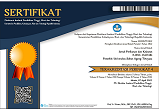Evaluation of Fermentation on Moringa Leaves (Moringa oleifera) as Raw Material on Feed of Tilapia (Oreochromis niloticus) )
Abstract
Moringa leaves is a potential ingredient for raw material of tilapia feed, which a high protein content of 25%. However, moringa leaves has a high fibre and antinutritional factors. The aims of this study was to evaluate the fermentation of Moringa leaves (Moringa oleifera) as a raw material feed on tilapia (Oreochromis niloticus). This study was conducted for eight months at Laboratory of Aquaculture, Department of Fisheries, Faculty of Agriculture, University of Sultan Ageng Tirtayasa. The study consisted of 4 treatments of feed with different fermentations, namely: A: reference feed 70% + Moringa leaves meal 30%, B: reference feed 70%+fermented Moringa leaves meal with Rhizopus oligosporus 30%, C: reference feed 70%+fermented Moringa leaves meal with Saccharomyces cereviceae 30%, and feed D: reference feed 70%+fermented Moringa leaves meal with Aspergillus niger 30%. The results showed that feed with Moringa leaves fermentation using A. niger resulted in the best growth on tilapia compared to other treatments. Fermentation with A. niger and R. oligosporus on Moringa leaves produced the best nutrient digestibility value compared to other treatments. Moringa leaves fermented with A. niger, S. cerevisiae and R. oligosporus had no effect on physiological processes on tilapia, as shown by hematological parameter values that were within the normal range. Moringa leaves fermented with Aspergillus niger can be used as a raw material for tilapia feed.
Keywords
Full Text:
PDFReferences
Afebrata RD, Limin S & Suparmono. 2014. Substitusi Tepung Onggok Singkong Sebagai Bahan Baku Pakan Pada Budidaya Nila (Oreochromis niloticus). e-Jurnal Rekayasa dan Teknologi Budidaya Perairan (II):2302-3600 hlm.
fuang W, Siddhuraju P & Becker K. 2003. Comparative Nutritional Evaluation of Raw, Methanol Extracted Residues and Methanol Extracts of Moringa (Moringa oleifera Lam.) Leaves on Growth Performance and Feed Utilization in Nile Tilapia (Oreochromis niloticus L.). Aquaculture Research (34): 1147-1159 pp.
Archana G and Arun K. 2015. Haematological Studies of Some Edible Fresh Water Fishes of NRC Region. World Journal Pharmacy and Pharmaceutical Sciences (4): pp 1467-1479.
Blaxhall PC dan Daisley KW. 1973. Routine Haematological Methods for Use with Fish Blood. J. Fish Biol. 5:771-781.
Buckle KA, Edwards RA, Fleet GH & Wooton M. 2013. Ilmu pangan. Jakarta: Universitas Indonesia. 365 hlm.
Chowdhury DK. 2011. Optimal feeding rate for nile tilapia (Oreochromis niloticus). [TESIS]. Norwegian: Department of Animal and Aquacultural Sciences Master Thesis. University of Life Sciences.
Handajani H. 2011. Optimalisasi substitusi tepung Azolla terfermentasi pada pakan ikan untuk meningkatkan produktivitas ikan nila gift. Jurnal Teknik Industri (12):177-181 hlm.
Harver & Hardy. 2002. Fish Nutrition: Bionergetics. Academic Prees: California USA.
Huisman EA. 1987. Principles of Fish Production. Department of Fish Culture and Fisheries, Waganingen Agriculture University, Waganingan, Netherland. 170p.
National Research Council. 1993. Nutrient Requirement of Fish. National Academic Press. Washington D. C. 273pp.
Putra AN, Widanarni, Utomo NBP. 2015. Growth performance of tilapia (Oreochromis niloticus) fed with probiotic, prebiotic and synbiotic in diet. Pakistan Journal of Nutrition 14: 263‒268.
Rachmawati FN, Untung S, dan Yulia S. 2010. Respon Fisiologi Ikan Nila, Oreochromis niloticus, yang Distimulasi dengan Daur Pemuasaan dan Pemberian Pakan Kembali. Nasional Biologi. 1(7): 492-499.
DOI: http://dx.doi.org/10.33512/jpk.v8i2.6726
Refbacks
- There are currently no refbacks.



_-_Copy1.png)